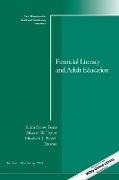Read more
This is the 141st volume of this Jossey-Bass series. Noted for its depth of coverage, it explores issues of common interest to instructors, administrators, counselors, and policymakers in a broad range of adult and continuing education settings, such as colleges and universities, extension programs, businesses, libraries, and museums.
List of contents
EDITORS' NOTES 1 Karin Sprow Fort'e, Edward W. Taylor, Elizabeth J. Tisdell 1. Sociocultural Issues in Adult Financial Education 5 Karin Sprow Fort'e This chapter introduces the volume on financial literacy education and discusses the role of sociocultural factors, such as race, gender, socioeconomic class, language, and age, in adult learning. 2. Structural Barriers, Financial Exclusion, and the Possibilities of Situated Learning for Financial Education 15 Jerry Buckland This chapter explores financial exclusion through the lens of adult situated learning in financial education. 3. Contextual Influences on Financial Behavior: A Proposed Model for Adult Financial Literacy Education 25 Wendy L. Way An ecological model is used to demonstrate the importance of multiple contextual influences on financial behavior and learning to inform research design and practice aimed at enhancing financial capability. 4. Financial Literacy Education for Women 37 Jodi Jarecke, Edward W. Taylor, Tahira K. Hira This chapter provides an overview of financial education for women, specifically exploring pedagogical approaches in women's financial education programs and offering strategies for teaching women about finance. 5. Financial Literacy: A Critical Adult Education Appraisal 47 Leona M. English This chapter provides a critical view of financial literacy education, exploring its assumptions and needs in curricula and in the people being taught to be financially literate. 6. Economic Inclusion and Financial Education in Culturally Diverse Communities: Leveraging Cultural Capital and Whole-Family Learning 57 B'arbara J. Robles The utility of recognizing the whole-family learning process in financial education is explored in this chapter, focusing on traditionally marginalized communities. 7. Raising Employee Engagement Through Workplace Financial Education 67 Lois A. Vitt Addressing changes in the employment landscape, this chapter offers a look at workplace financial education and argues for employers taking a greater role in educating employees. 8. Measuring the Impacts of Financial Literacy: Challenges for Community-Based Financial Education 79 J. Michael Collins, Karen C. Holden This chapter discusses the difficulty in assessing financial education effectiveness, and how the assessments have the potential to enlighten researchers about financial education across the lifespan. 9. The Role of Emotions and Assumptions in Culturally Responsive Financial Education Practice in a Capitalist Economy 89 Elizabeth J. Tisdell This chapter concludes the volume with further discussion of assumptions of financial education, and then examines culturally responsive financial education practice and the role of emotions, beliefs, and attitudes. INDEX 99
Summary
Many adults attend financial education classes to help them make more informed financial decisions, based on their knowledge of their financial situation available cash or funds planned expenditures.

